Розробка уроку "The Key to the House"
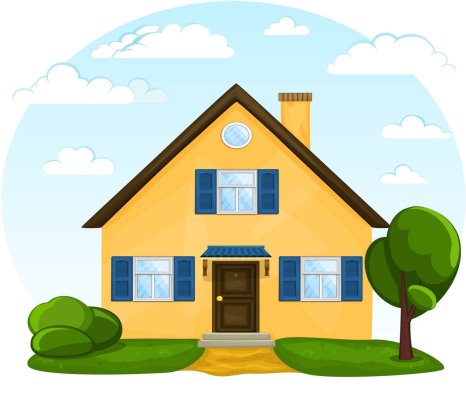
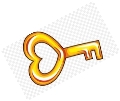
План-конспект уроку
“The Key to the House”
Підготувала: вчитель
англійської мови ЗЗСО І-ІІІст. №4
Марчук О.Т.
м. Жмеринка 2021 р.
Тема уроку: The Key to the House
Мета уроку:
- повторити та опрацювати в мовленні учнів лексичні одиниці теми «Помешкання»;
- формувати базові поняття про частини мови в англійській мові;
- тренувати учнів в формуванні складних іменників;
- практикувати учнів в описі кімнати, вживаючи прийменники місця та вирази “There is…”, “There are…”.
Очікувані результати:
учень може:
- називати та писати 8-10 слів теми «Помешкання»;
- утворювати складні іменники;
- описувати свій дім та кімнату, вживаючи вирази “There is…”, “There are…”, складні іменники, прикметники та прийменники місця
(4-5 речень);
- висловлювати своє ставлення до свого місця проживання.
Обладнання: телевізор, мультимедійна презентація до уроку, девіз уроку “My house is my castle” (English Proverb), відео на пісню-вітання “Every Day Hello Song” та пісні “House Song”, “Where’s the Monkey?”, “House Song: Big or Small”, “Good bye Song”, хмара тегів для відгадування теми уроку, роздатковий матеріал для роботи в групах, відерця для проведення змагання, вказівники для формування груп, браслети для рефлексії, cмайлики, картки-самооцінювання (кольорові яблука-стікери).
Тип уроку: урок розвитку умінь усної взаємодії.
Методи і прийоми навчання: вправа «Настрій», «криголам», «хмара тегів», «добери пару», «відгадай загадку», «анаграми», «коло слів», відеоскрайбінг для фонетичної зарядки, лексична розминка, мовна здогадка, робота в групах, робота в парах, рефлексія, самооцінювання.
Хід уроку
І. Introduction. Підготовка до сприймання іншомовного мовлення.
1. Greeting.
T: Good morning, children! I’m glad to see you! Are you ready to start a lesson? Let’s start it with a song of greeting. Who will help me today to demonstrate the movements?
1) Song “Every Day Hello Song”. ( https://www.youtube.com/watch?v=gghDRJVxFxU )
2) Circle of Mood.
T: Dear pupils! How are you feeling today? Hope you are in a good mood. Let’s create our “Circle of Mood”. On your desks you have different smiley faces. Choose one and stick it somewhere around the sun on the blackboard.
Ps: I’m fine / great / wonderful…
2. The aim of the lesson and learning outcomes. Мета уроку та очікувані результати.
T: Children! What do you think we are going to do at the lesson?
Ps: Sing/ play games/ guess riddles/ write topical words/ work in groups/ make up dialogues/ exercise/ speak English.
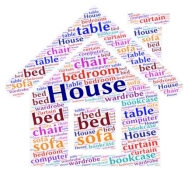 T: Yes, you are right. And what we will talk about you will guess with the help of a word cloud. Look and say, please.
T: Yes, you are right. And what we will talk about you will guess with the help of a word cloud. Look and say, please.
The topic of our lesson is “The Key to the House”. We are going to talk about a house, some rooms, furniture and its place in the room. Besides, we’ll learn about the use of simple nouns, compound nouns, adjectives and prepositions of place in describing your dwellings. So, by the end of the lesson you’ll be able to tell about your houses and furniture, describe rooms using expressions there is/there are, compound nouns, adjectives and prepositions of place.
II. Warm-up. Введення учнів в мовне середовище за темою уроку.
- Icebreaker. 1) Wisdom Words. T: There is an English proverb:
“My house is my castle.” Can you translate it? How do you understand these words?
This proverb will be the motto of our lesson.
2) Brainstorming. What other synonyms to the word “house” can we use?
Meaning of the Word: A synonym is a word or phrase that means exactly or nearly the same as another word or phrase in the same language.
Synonyms can be any part of speech.
Ps: We can say a building / a flat/ a castle/ a cottage/ a villa/ a palace/ a residence…
-
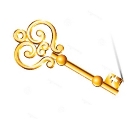 Phonetic Drills. 1) Rhyme “This Is the Key of the House”.
Phonetic Drills. 1) Rhyme “This Is the Key of the House”.
This is the key of the 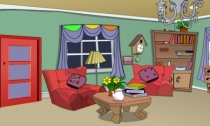 house.
house.
In the house there is a room.
In the room there is an
armchair.
Near the armchair there is a table.
On the table there is a vase.
In that vase there are some flowers. I love them.
-
 Lexical Drills.
Lexical Drills.
- Naming the Room. T: Look at the picture and name the rooms. There is a…
- Guessing a Riddle “What Room is It?”
It is a place where we sleep (a bedroom)
It is a place where we can wash our face and hands
(a bathroom)
It is a place where we can cook and wash the dishes
(a kitchen)
It is a place where we can watch TV and read books (a living room)
III. Main Part
- Vocabulary Review and Practice.
- Game “Building a House”.
T: It’s high time to build our own house. We’ll do it in groups of four according to the rooms you’ve named: bedroom, living room, kitchen, bathroom. Let’s join into groups.
You have a set of words. Your task is to put the letters in these words in the right order and find out the words on the topic “My house”. When the group is ready, please, raise your fly swatter.
r o b d e o m, l a h l, t e k i c h n, n d i i g n o o r m, t h b a o o r m, s d y u t,
l e t t o i , r e n ‘s h c i d l m o o r.
2) Making up sentences. T: Now make up two sentences with these words using the phrases like: “We have got…”, “There is a …” Try not to repeat the name of the room which has already been mentioned.
Ps: We have got a kitchen in our house. / There is a bathroom in our house.
- Singing “House Song” (https://www.youtube.com/watch?v=DVZvC9e5oYw)
T: Now we can invite our guests to our house. Let’s do it with the help of a “House Song”.
- Speaking. Group Work.
- Regrouping.
T: Can you recollect the names of the rooms mentioned in the song?
Ps: A sitting room, a kitchen, a bathroom, my/ children’s room.
T: OK! Now we’ll work in three groups: kitchen, bathroom, children’s room.
We will play “Attention” Game.
- “Attention” Game.
T: Each group will get its Picture Card. Your task is to mark the furniture that you can
find in your room with the help of these colourful clothes pegs? Be attentive!
Some things you cannot find in your room. So, you should work together, in cooperation. When the group is ready, please, raise your fly swatter. After that your group will tell us what there is in your room.
- Telling about the room furniture.
T: The members of the other groups should be ready to ask about the things that there aren’t in the proper room.
- Grammar Point. Word Formation. Compound Nouns.
1) T: Children when we name some pieces of furniture we use such part of speech as a noun. Actually, nouns are the largest word class in English. A noun is a word that refers to a thing (book), a person (Betty Crocker), an animal (cat), a place (Zhmerynka) or an idea (fiendship). They can be simple and compound.
Meaning of the Word: A compound noun is a noun formed by two or more words. Such nouns normally have two parts. A compound noun often has a meaning that is different, or more specific, than the two separate words. e.g. housewife.
The word can be written as two words: (living room), sometimes it is joined by a hyphen (dining-table), but more often it is written as one word (football).
2) Game “Find a Pair”.
T: Now you will form some compound nouns. Some of you will get flashcards with pictures; others will have flashcards with words. You have to find your pair, create a word and match it to the picture: bedroom, cupboard, bookcase, TV set, fireplace, armchair, bookshelf, bathroom.
- Pair Work.
T: Now make up dialogues and ask each other whether there is this piece of furniture in your house. Don’t forget to use the prepositions of place. Do you remember them?
Ps: on, in, under, next to, between, above, behind…
T: Follow the example:
- Is there a … in your house?
- Yes, … … . / No, … … .
- Where is it?
- It is ….
- Relaxation. Song “Where’s the Monkey?” (https://www.youtube.com/watch?v=idJYhjGyWTU)
T: Now come back to your places and let’s do some exercises to the song “Where’s the Monkey?”
- Team Game “Full Bucket”.
1) T: Thank you very much. Take your seats. Now you’ll work in two big teams. One team is to my right hand, another one is to my left hand. Please, take a clean sheet of paper, a pen and write one furniture word. Try not to repeat the words. When you write a word, crumple your sheet, throw it into a bucket and stand at the blackboard. Then join into a column facing a bucket.
2) Checking the word spelling.
T: OK. It’s high time to check the spelling of the words. For this we will exchange the buckets. In turn you will come to the bucket, take a paper ball, unfold it, read the word and check the spelling.
- Describing a House. The Use of Adjectives.
- T: Children, when we describe our houses we often use different adjectives. Do you know some of them?
Meaning of the Word: Adjectives are one of the four major word classes, along with nouns, verbs and adverbs. Adjectives are words that describe the qualities or states of nouns. They give us more information about people, animals or other things.
e.g. That’s a big house.
2) Song “House Song: Big or Small” (https://www.youtube.com/watch?v=jUNTMKpoLAI&t=15s)
3) Speaking “Welcome to my House”.
IV. Summarizing. Заключна частина уроку.
1. Home Assignment. T: Draw a picture of your room and write 5 -6 sentences describing it. Use some compound nouns, adjectives and prepositions of place.
2. Evaluation and feedback.
1) T: Let’s do some memory nodes.
2) T: Look! You have apple-stickers of different colours on your desks. They are self – evaluation cards. Please, evaluate your work at the lesson and stick an apple on our tree. If you were active at the lesson and worked excellent choose a green apple. If you were not so active and did some mistakes choose a yellow sticker. If you think you were passive choose a pink one. Now it’s our tree of success. The lesson is over. Good bye.
3) Good bye Song (https://www.youtube.com/watch?v=2O975ewRT7Q)
1


про публікацію авторської розробки
Додати розробку
